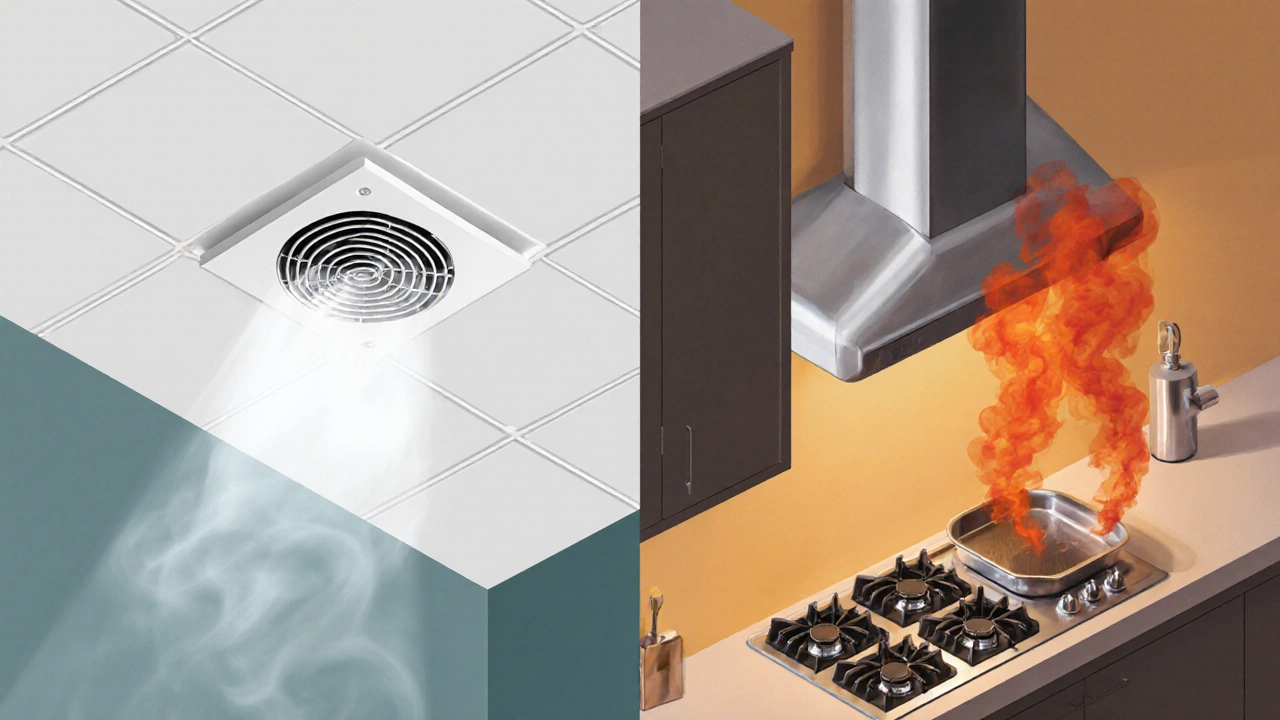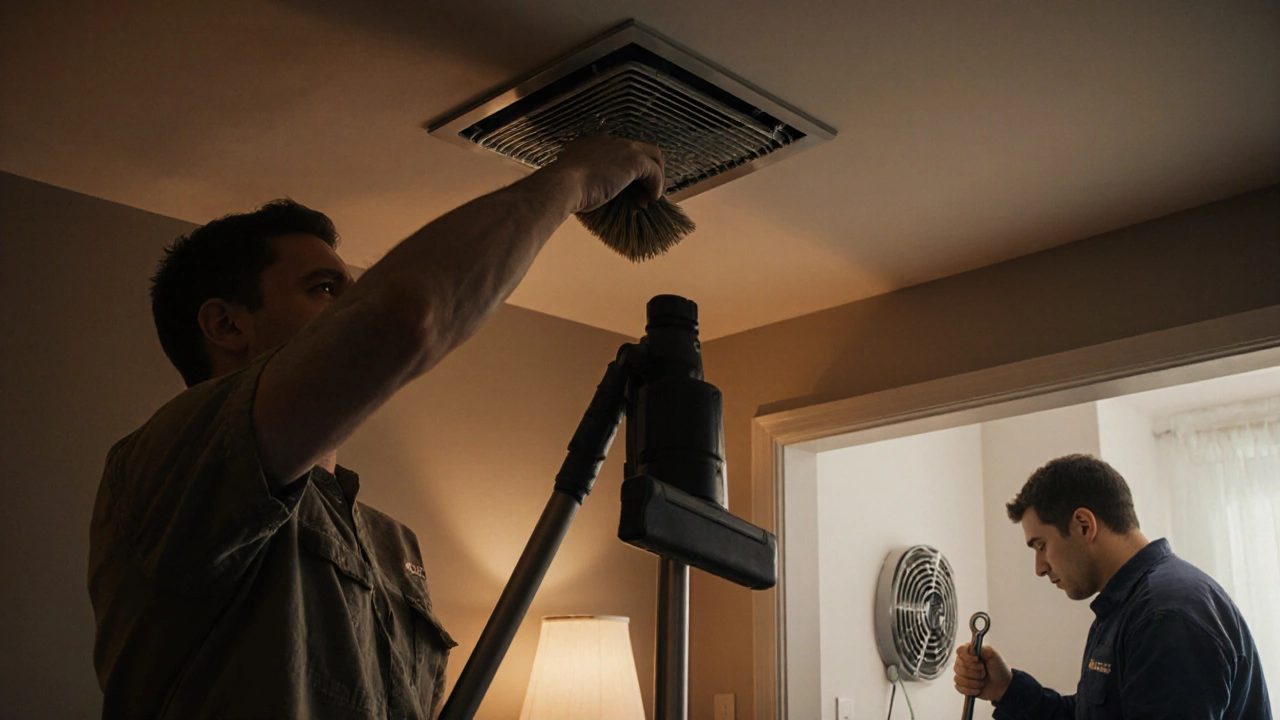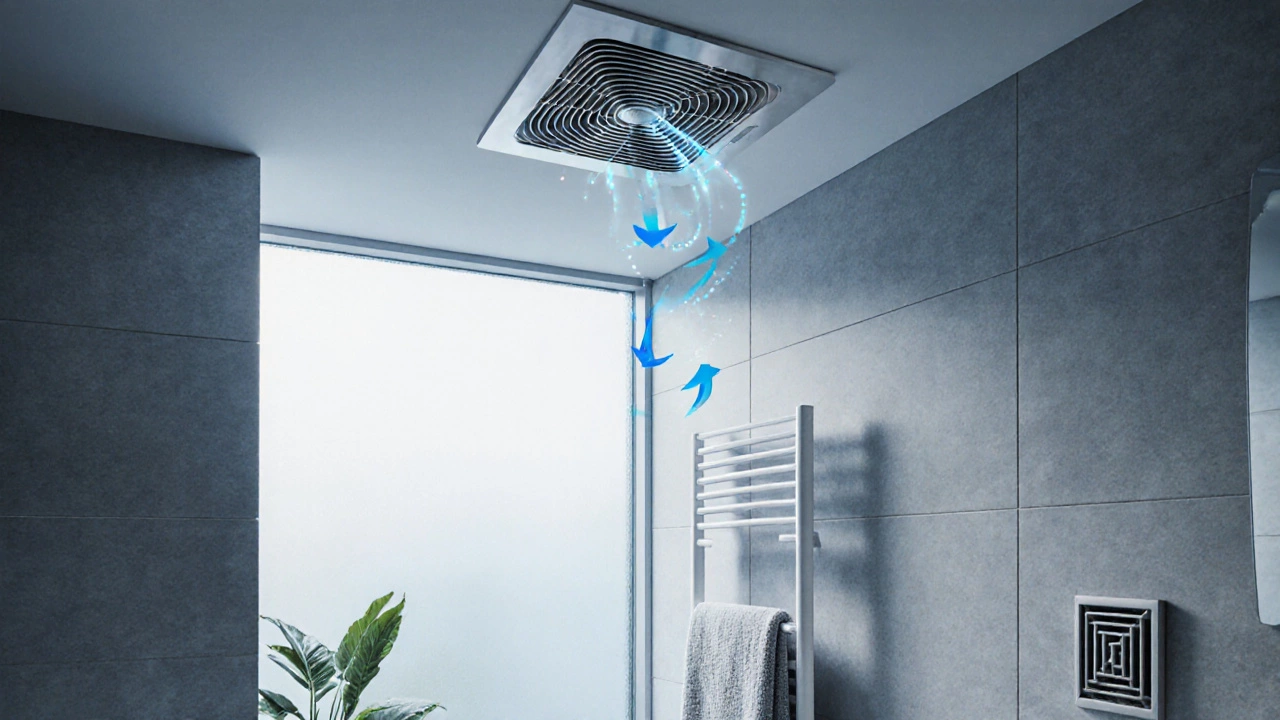Fan Sizing Calculator
Ever wondered why your bathroom feels fresh while the kitchen still smells like fried onions? The answer usually lies in the type of fan you have. The ventilation fan and the extractor fan often get lumped together, but they serve different jobs, are built differently, and need separate care. Below we’ll break down what each does, where they belong, and how to keep them humming.
What a Ventilation Fan Actually Does
Ventilation Fan is a device that continuously circulates air to dilute indoor pollutants and control humidity. Think of the ceiling‑mounted unit in a bathroom or the low‑profile grille in a laundry room. Its job isn’t to pull out cooking fumes; it simply moves air around, letting stale air escape through a passive vent or a simple duct.
Because it runs most of the time, a ventilation fan is usually quieter and uses a smaller motor. It’s designed for balanced airflow-measured in CFM (cubic feet per minute)-that matches the room size. The goal is steady dilution, not high‑speed extraction.
Extractor Fan: The Heavy‑Duty Sibling
Extractor Fan is a high‑capacity unit that pulls out moisture, smoke, grease, and strong odors from a specific space. You’ll find them above kitchen ranges, in industrial workshops, or as part of a bathroom's humidity‑control system when the regular fan can’t keep up.
Extractor fans are built for short bursts of high airflow. They often have a larger Motor and a dedicated Vent Pipe that carries the air straight outside. Because they move a lot of air quickly, they’re louder and consume more power.
Side‑by‑Side Comparison
| Feature | Ventilation Fan | Extractor Fan |
|---|---|---|
| Primary Purpose | Continuous air turnover | Rapid removal of moisture, smoke, grease |
| Typical Locations | Bathrooms, laundry rooms, small utility spaces | Kitchens, workshops, large bathrooms |
| Airflow Rating | 50‑100 CFM for a standard bathroom | 150‑300 CFM or higher for kitchen hoods |
| Installation | Often recessed, connected to a simple vent grille | Mounted to a chimney or external vent duct, may need a dedicated pipe |
| Noise Level | Typically 20‑30 dB | Usually 35‑55 dB, depending on speed settings |
| Power Consumption | 5‑15 W | 30‑100 W |
| Maintenance Frequency | Clean grill annually | Clean motor and vent pipe every 6‑12 months |

How to Choose the Right Fan for Your Space
If you’re deciding between the two, start with the room’s function. A bathroom that only needs to remove humidity can rely on a simple ventilation fan. Look for a unit with a Static Pressure rating that matches the length of your duct run-low static pressure means it can push air through longer runs without losing efficiency.
For a kitchen where grease particles coat surfaces, an extractor fan is the only sensible choice. The fan must handle higher Airflow and be able to vent through a dedicated pipe that can resist oil buildup. Many homeowners pair an extractor fan with a secondary ventilation fan to keep the overall indoor air quality high.
Maintenance Tips that Keep Both Fans Working
- Turn off power before cleaning. Unplug or switch off the circuit breaker.
- Remove the cover grille and vacuum the dust with a soft brush.
- For extractor fans, detach the vent pipe and scrub any grease using a mild degreaser.
- Check the Motor bearings for wobble; replace if noisy.
- Test the fan’s speed settings. If the low speed struggles to move air, the motor may be wearing out.
Regular cleaning not only prolongs life but also preserves the Noise Level specifications you paid for. A clogged fan can easily jump from 25 dB to over 50 dB, which drives anyone crazy.

Common Misunderstandings and How to Avoid Them
Many DIYers assume a ventilation fan can double as an extractor fan simply by swapping the cover. That’s a mistake. The motor’s capacity, duct size, and back‑pressure tolerance are engineered for specific tasks. Installing a low‑CFM ventilation fan in a kitchen will leave greasy films on walls and a lingering “fried‑food” smell.
Another pitfall: using the wrong vent pipe diameter. An extractor fan designed for a 100 mm pipe will under‑perform if you downgrade to a 80 mm pipe, increasing static pressure and trimming airflow. Always match the pipe diameter to the manufacturer’s recommendation.
Lastly, positioning matters. A ventilation fan should be placed where fresh air can enter-usually opposite a window or an intake vent. An extractor fan’s outlet must be as short and straight as possible to minimize resistance.
When to Call a Pro
If you notice persistent moisture, mold spots, or a persistent odor after cleaning, it’s time to get an expert in. Professional technicians can test actual CFM output, inspect wiring, and ensure the venting complies with local building codes-especially important in Auckland where council regulations require external vent pipes to be weather‑proof.
Typical repair scenarios include motor burnout, faulty speed switches, and broken vent pipe seals. A qualified repair person will also verify the fan’s energy‑efficiency rating, which can affect your electricity bill.
Frequently Asked Questions
Do ventilation fans and extractor fans use the same electricity?
No. Ventilation fans are low‑power devices (5‑15 W) that run continuously, while extractor fans need more power (30‑100 W) for short bursts of high airflow.
Can I replace a bathroom ventilation fan with an extractor fan?
You could, but it’s overkill. An extractor fan will be louder, consume more power, and may require a larger vent pipe that your bathroom wall isn’t ready for.
How often should I clean my extractor fan?
Aim for every 6‑12 months, especially if you cook greasy foods. If you notice reduced suction or increased noise, clean it sooner.
What CFM rating do I need for a 12‑square‑metre kitchen?
A good rule of thumb is 100 CFM per square metre of cooking area. For a 12 m² kitchen, look for a fan that can push at least 1200 CFM on high speed.
Is it okay to install a ventilation fan without an external vent?
Only if you have an internal return air path (like a window or an intake grille). Without any vent, the fan will just recirculate stale air, defeating its purpose.


